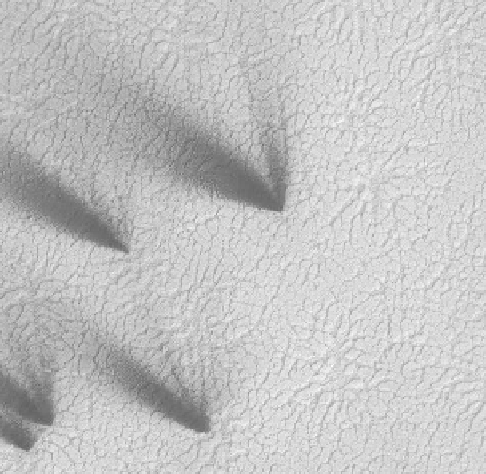Geology Reference
In-Depth Information
Figure 7.28. Dark deposits thought to result from geysers generated
by heating of the surface and release of volatiles from shallow
subsurface reservoirs (NASA HiRISE PSP_003364_0945, part).
thought to result from a type of
“
solid state
”
greenhouse in
which sunlight penetrates the ice, heats the contact zone
with the underlying rocky materials, and sublimates the
ice to form a high-pressure gas that ruptures the ice
explosively.
While recently formed craters and the presence of water
on and near the surface show that impact, hydrologic, and
periglacial processes are active today, by far the most
prevalent surface modi
cations are from aeolian activity.
Even before the first mission flew to Mars, Earth-based
telescopic observations showed seasonal patterns of
brightening, some of which were attributed to dust storms.
Subsequent data show that dust is lifted by the wind
locally and regionally, with some storms completely
enshrouding the globe in as little as one month. One
such global storm was raging across the planet when the
Mariner 9 orbiter arrived, and imaging of the surface had
to await the settling of dust from the atmosphere. In
contrast to common windblown dust on Earth, which is
10
Figure 7.26.
dubbed thus for its pitted
morphology, occurs in the south polar region and is thought to result
from the sublimation of ice, leaving irregular-shaped depressions.
Repeated imaging shows that the features enlarge with time. This
image covers an area 2.5 km by 3.5 km; the pits are about 4m deep
(NASA MOC M0306646, part).
“
Cottage cheese terrain,
”
20 microns in diameter, martian dust is extremely
ne,
of diameter a few microns. Very strong winds are needed
to move such
fine grains, yet measurements from landers
suggest that such winds are rare. However, the discovery
of dust devils in Viking Orbiter images suggests an effec-
tive mechanism for lifting dust into the atmosphere. Dust
devils are local vortexes formed by heating of the surface,
which act like vacuum cleaners in that they suck dust from
-
Figure 7.27.
is characterized by radial fractures,
some of which leave fan-shaped deposits of dark material; the area
shown is 540 km by 470m (NASA HiRISE ESP_014413_0930 part).
“
Spider terrain
”





